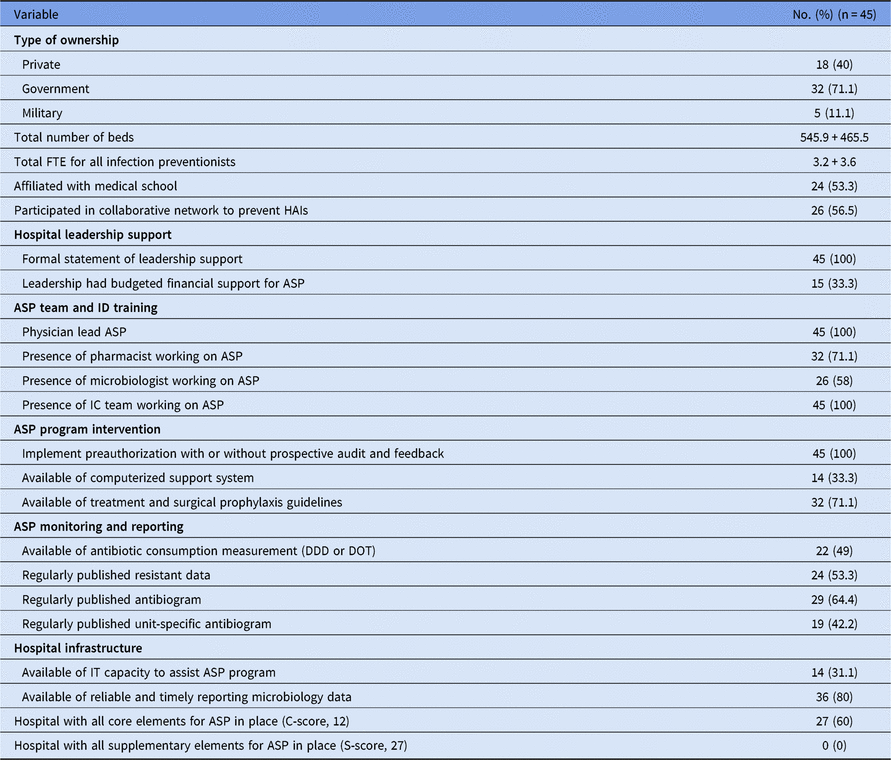To the Editor—Implementation of an antimicrobial stewardship program (ASP) in an acute-care setting requires several important components: hospital administration support, an appropriate ASP team (eg, infectious disease physician(s) and pharmacist(s)), ASP program goals and carefully planned interventions, a structured reporting system, adequate hospital infrastructure, and mechanisms for education.Reference Apisarnthanarak, Kwa and Chiu 1 Examination of these components can provide a useful gap analysis for acute-care hospitals in various resource settings to fulfill the hospital ASP goals. To evaluate the feasibility of gap analysis based on previous ASP consensus in Asia,Reference Apisarnthanarak, Kwa and Chiu 1 we performed a survey of hospital components and analyzed the gaps to help inform the implementation of ASP in central Thailand.
From February 1, 2019 through May 31, 2019, investigators (A.A. and K.J.) interviewed key personnel in central Thailand hospitals to assess the implementations of ASPs in acute-care settings. All hospitals in central Thailand that had an intensive care unit (ICU) and at least 250 hospitals beds were invited to participate (n = 56). The list of hospitals was obtained from Thai Ministry of Public Health. The gap analysis survey instrument was modeled from a previous publicationReference Apisarnthanarak, Kwa and Chiu 1 and included assessment of several components including hospital administration support, ASP team membership and training, ASP program and interventions, structured reporting system, hospital infrastructure and education. Each component was subdivided into core gaps (C score comprised of of 12 components) and supplementary gaps (S score comprised of 27 components) (Supplement 1 online). Data collected also included general hospital characteristics, affiliation with a medical school, personnel, infection control program characteristics, and total full-time equivalent for all infection preventionists. The following hospital characteristics were considered: type of ownership, number of acute-care beds, affiliation with a medical school, and involvement in a collaborative network to reduce healthcare-associated infections. In-person interviews were administered by A.A. and K.J., who used the survey instrument to interview ASP leaders in each of the acute-care hospitals in central Thailand. Both interviewers were familiar with the gap analysis tool. Descriptive statistics were calculated for all relevant survey questions. Multivariable logistic regression was used to determine factors associated with hospitals that achieved all essential 12 C-score components.
Overall, 45 of 56 hospitals (80%) participated in our survey. Of these, 27 hospitals (27 of 45, 60%) fulfilled all C-score components (C score, 12), whereas none of the participated hospitals fulfilled all S-score components. Although a formal statement of ASP support from leadership was available from all hospitals, only 15 of 45 hospitals (33%) received financial support for their ASP activities. For core component assessment, microbiologist and pharmacist involvement in ASP, process and outcome measurements, regularly published antimicrobial resistant data were lacking for several hospitals (Table 1). For supplementary component assessment, lack of information and technology (IT) to support ASP, lack of available treatment and surgical prophylaxis antibiotic guidelines and unit-specific antibiograms, lack of a monitoring system for ASP process and outcomes were reported by several hospitals (Table 1). In multivariable regression analyses, participation in any collaborative network to reduce healthcare-associated infections (adjusted odds ratio [aOR], 19.9; 95% confidence interval [CI], 12.4–249.2; P < .001) and medical school affiliation (aOR, 36.6; 95% CI, 6.3–144.5; P < .001) were independent factors associated with fulfillment of all C-score components.
Table 1. Hospital Characteristics and Gap Analysis

Note. FTE, full-time equivalent; HAIs, healthcare-associated infections; ASP, antimicrobial stewardship program; ID, infectious diseases; DDD, days on therapy; DOT, days on treatment; C-score, core component score; S-score, supplementary component score.
In this survey, we identification of several existing gaps and factors associated with fulfillment of core components among tertiary-care hospitals in central Thailand. To overcome those core gaps, hospitals need to provide hospital administrators with a possible business case to persuade funding for an ASP, prioritize identification of key ASP team members (eg, clinical pharmacist, microbiologist), and prioritize selection of a combination of process and outcome related measures for the ASP as well as mechanisms to monitor compliance (Supplement 2). Previous publications have suggested the role of participating in collaborative network to prevent HAIs as one of the predictors of successful reduction in nosocomial infections and multidrug-resistant organisms. Reference Apisarnthanarak, Greene, Kennedy, Khawcharoenporn, Krein and Saint2–Reference Apisarnthanarak, Ratz and Khawcharoenporn4 We expanded this association as one of the key prerequisites for hospitals to fulfill the core components gaps for ASP. Notably, all hospitals had not fulfilled supplementary gaps and need to prioritize acquiring adequate IT support. All hospitals also need to develop plans to provide regular feedback to prescribers, to monitor process and outcome related measures, and to report ASP performance to relevant stakeholders as well as hospital administrations (Supplement 2 online).
Our study had some limitations. First, because the response rate was <100%, our results may be susceptible to nonresponse bias. Second, because we relied on self-reported data from the ASP leader at each facility to determine the frequency of the various gap analyses, our results may be susceptible to respondent bias. Finally, we did not have access to (and thus could not adjust for) hospital case-mix data. As such, our regression estimates could be biased because of unmeasured confounding, and our results can only be interpreted as providing evidence for associations rather than causal mechanisms. Despite these limitations, our study identified several gaps, and we have suggested mechanisms for overcoming such barriers. As part of ongoing efforts to build and maintain successful ASP in Thailand, national policy makers should regularly implement gap analyses for acute-care hospitals and provide adequate supports for those unmet need.
Supplementary material
To view supplementary material for this article, please visit https://doi.org/10.1017/ice.2019.185.
Author ORCIDs
Anucha Apisarnthanarak 0000-0001-6390-9519
Acknowledgements
None.
Financial support
No financial support was provided relevant to this article.
Conflicts of interest
All authors report no conflict of interest relevant to this article.



